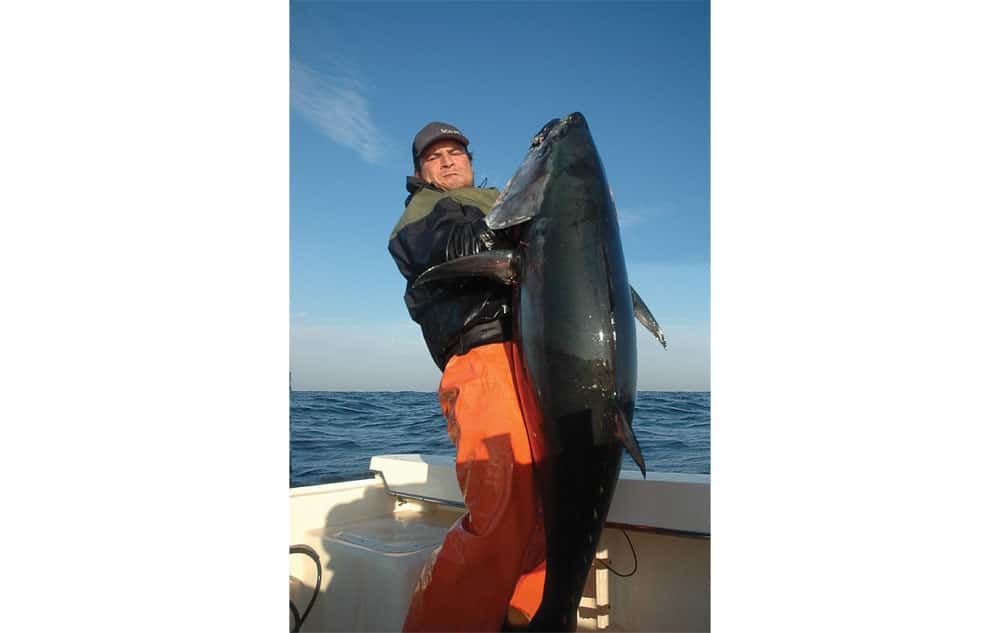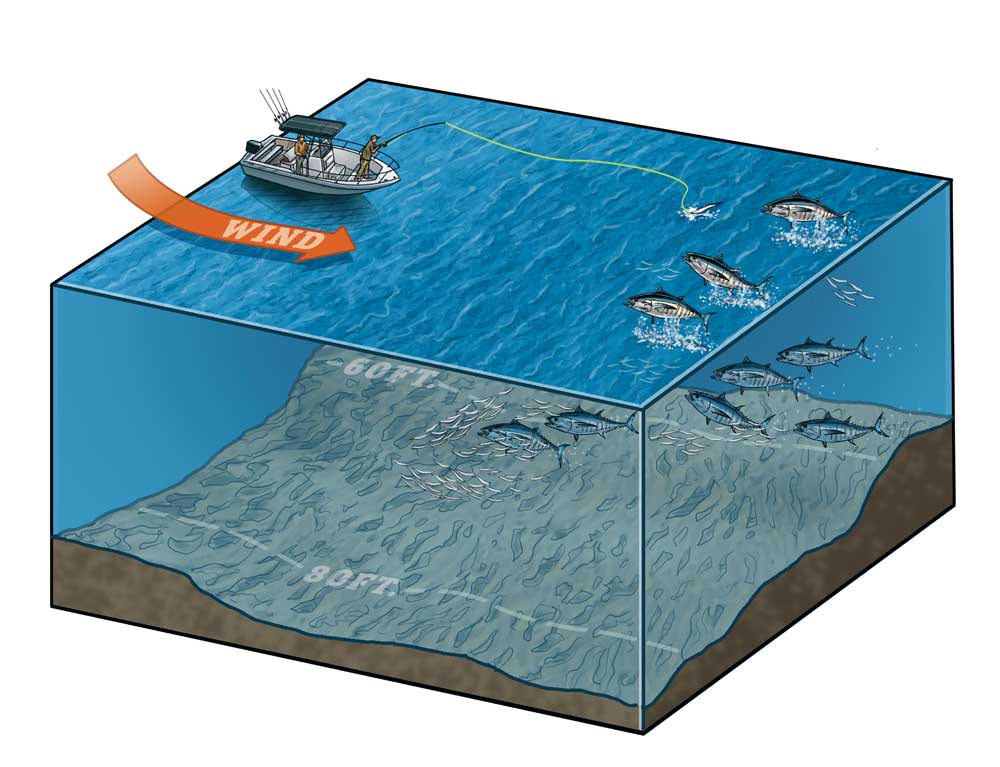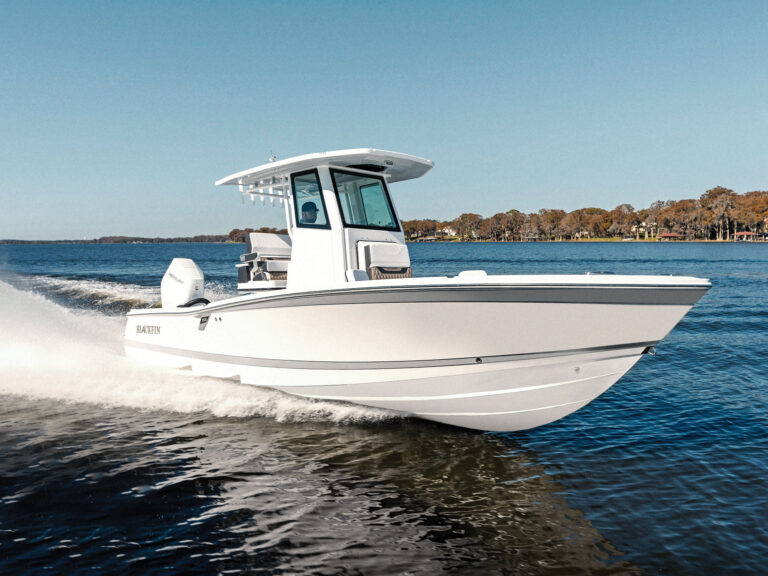“Tuna busting all over, and close!” came an excited voice on the VHF. Such sightings certainly weren’t unheard of, but as far as I knew, no one had ever landed one. That wasn’t for lack of trying. I’d cast to them in prior years, but they didn’t appear interested. Still, we decided to take a look.
As we closed in, we watched high-flying birds change direction and drop down, then large, dark-blue backs slashed through the water underneath. It was over before we got close. Then, without warning, they exploded 40 feet off our stern. Grabbing the closest rod, I threw a Slug-Go into the mayhem. It hit the water, and a frighteningly large tuna tried to grab it and missed. Well undergunned, I was relieved, but before I could pull it out, another bluefin pounced on it. A few expletives and 15 seconds later, we were dangerously close to getting spooled. Two hours later, we miraculously landed an 80-pound bluefin four miles from Sandy Hook.
Since then, I’ve geared up and spent most of November and December chasing these things. There are days where you’ll find eager fish, but it’s the exception, not the rule. These are truly fish of a thousand casts, but odds are getting better. In the past six or seven years, a small fleet is beginning to get it wired.
What’s the Story?
Because this fishery is still in its infancy, it’s hard to say if these bluefin were always around and anglers just couldn’t catch them, or if their appearance is a recent occurrence. These are migratory fish, making their way south. Occasionally, boats trolling bunker spoons would get inexplicably spooled. “These fish were always pushing through,” says Capt. Gene Quigley of the Barnegat-based Shore Catch Guide Service. “If there’s bait, they will stay and feed.” The recent influx of 6- to 9-inch sand eels in 70 to 80 feet of water during November and December likely had a major impact. The less frequent but still abundant herring, mackerel and half-beaks inshore also bring these fish around.
Yet it’s hard to ignore the recent coastal abundance of bluefin — not just here, but everywhere. While bluefin populations are arguably a shadow of what they once were, any angler targeting them along the coast from Maine to North Carolina will tell you that there appear to be more bluefin around now than in the two previous decades.
Sami Ghandour — owner of Saltywater Tackle in Brooklyn, who specializes in plugs and jigs for tuna — acknowledges the recent abundance, yet he believes their presence is all about changing patterns in migration and distribution. “Only Mother Nature knows the reasons,” he says.
Capt. Adam Sherer, another Shore Catch guide, has landed more of these inshore bluefins than anyone. “They’ve always been around,” he says, “but the people targeting them weren’t catching, and so they’d just give up.”
“The knowledge and gear has progressed,” notes Travis Collins, proprietor of Spinal Rods and one of the most proficient inshore bluefin anglers out there. “So now people have confidence and are targeting them.”
Technique and Timing
You’ll seldom catch these tuna with traditional techniques like trolling, chunking and jigging. It’s challenging sight-casting. Sherer, Collins and Ghandour agree these fish are particularly demanding.
“It’s about positioning,” says Quigley. That means finding fish and positioning yourself. “These fish usually feed upwind,” says Collins. Ghandour recommends approaching 50 to 70 feet ahead of the school before casting. These fish will sound if you run up on them. “They are notoriously skittish in water less than 100 feet deep,” says Collins. It takes patience to stop and wait, unbearable when fish are busting a hundred yards away. But patience pays off when they come up around the boat, less wary and eager to take a bait.
If you want to succeed, you have to put in the time. These fish are moody. Some days, they stay up and eat; other days, you’d swear they aren’t catchable. No one has figured out why they are aggressive one day and wary the next, but having fished many scenarios, I’m certain it has nothing to do with moons, tides or weather.
Phantom Fish?
Whether due to changing patterns or better angling methods, no one is quite sure why bluefin tuna in the New York Bight have recently caught anglers’ attention. But the fish are here every year now, and more are caught each season as fishermen refine the speciaized techniques and tackle demanded by these impressive fish.
New York Bight Bluefin Basics
Japanese stickbaits, from 51⁄2 to 9 inches, weighing from 60 to 120 grams, account for 90 percent of the fish taken. At $20 to $250 each, they can be pricey, but they’re sized to imitate small baits, built to withstand the punishment of a 200-pound fish, heavy enough to make crucial long casts quickly, and have great action. “With a sweep-and-stop retrieve, stickbaits dart and dive erratically,” notes Ghandour. They can also be worked slowly to stay in the strike zone longer. “The most common mistake is trying to rip it through the school,” says Collins. Quigley recommends the floating versions on calm days, and sinking lures when the water is choppy.
Try plastics — the Ron-Z 4X Strong Z-Series with a 10-inch silver tail, 10-inch Double-Wide Hogy or a 9-inch Arkansas Shiner Slug — when fish are on sand eels. A slow-twitched retrieve on an unweighted weedless 8/0 hook is effective, though throwing them with the heavy gear that these fish require can be challenging.
Rods: 71⁄2- to 8-foot parabolic heavy-action spinning rods made for popping (Race Point 200, Sting-o Fish G-rod 7’6”, Spinal SPM8, or equivalents)
Reels: Van Staal VSB 250 and Stella 18000 or 20000SW or equivalent, capable of up to 50 pounds of drag
Lines: 60- to 100-pound hollow-core braid
Leader: 80- to 100-pound fluorocarbon wind-on leaders
Lures: Soft plastics: 1 Slug-Go Arkansas Shiner, 2 Hogy Double Wide, 3 Ron-Z 4X Strong; stickbaits: 4 Shimano Orca, 5 Smith Baby Runboh, 6 Tackle House Britt (saltywatertackle.com), 7 Daiwa Dorado Slider; Sting-o SeaThug, Tackle House Shibuki
New York Bight Bluefin Planner
Where and when these fish show up is variable. The general pattern is it begins in late October and lasts into January; they run the 70- to 80-foot line from Montauk to Cape May. Tuna are highly regulated. The 2012 recreational limit is one fish, between 27 and 73 inches, per vessel per day/trip. Verify rules at hmspermits.noaa.gov before you go.
What: Sight-casting for inshore bluefin tuna
When: November and December Where: 60 to 90 feet of water from Montauk to Central New Jersey
Who: Capt. Adam Sherer Capt. Gene Quigley 732-600-3297 shorecatch.com
Capt. Chris Hessert 917-531-4783 manhattanfly.com
Capt. John McMurray 718-791-2094 nyctuna.com














